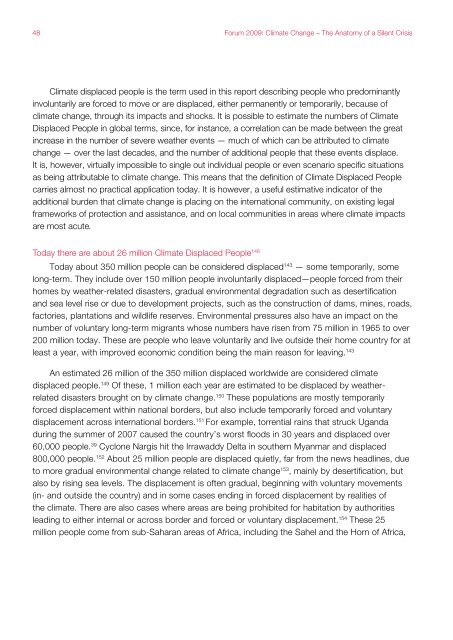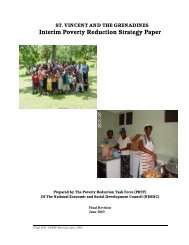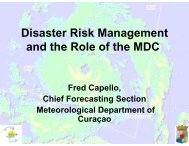The Anatomy of A Silent Crisis The Anatomy of A Silent Crisis
The Anatomy of A Silent Crisis The Anatomy of A Silent Crisis
The Anatomy of A Silent Crisis The Anatomy of A Silent Crisis
- TAGS
- anatomy
- www.bb.undp.org
Create successful ePaper yourself
Turn your PDF publications into a flip-book with our unique Google optimized e-Paper software.
48 Forum 2009: Climate Change – <strong>The</strong> <strong>Anatomy</strong> <strong>of</strong> a <strong>Silent</strong> <strong>Crisis</strong><br />
Climate displaced people is the term used in this report describing people who predominantly<br />
involuntarily are forced to move or are displaced, either permanently or temporarily, because <strong>of</strong><br />
climate change, through its impacts and shocks. It is possible to estimate the numbers <strong>of</strong> Climate<br />
Displaced People in global terms, since, for instance, a correlation can be made between the great<br />
increase in the number <strong>of</strong> severe weather events — much <strong>of</strong> which can be attributed to climate<br />
change — over the last decades, and the number <strong>of</strong> additional people that these events displace.<br />
It is, however, virtually impossible to single out individual people or even scenario specific situations<br />
as being attributable to climate change. This means that the definition <strong>of</strong> Climate Displaced People<br />
carries almost no practical application today. It is however, a useful estimative indicator <strong>of</strong> the<br />
additional burden that climate change is placing on the international community, on existing legal<br />
frameworks <strong>of</strong> protection and assistance, and on local communities in areas where climate impacts<br />
are most acute.<br />
Today there are about 26 million Climate Displaced People 148<br />
Today about 350 million people can be considered displaced 143 — some temporarily, some<br />
long-term. <strong>The</strong>y include over 150 million people involuntarily displaced—people forced from their<br />
homes by weather-related disasters, gradual environmental degradation such as desertification<br />
and sea level rise or due to development projects, such as the construction <strong>of</strong> dams, mines, roads,<br />
factories, plantations and wildlife reserves. Environmental pressures also have an impact on the<br />
number <strong>of</strong> voluntary long-term migrants whose numbers have risen from 75 million in 1965 to over<br />
200 million today. <strong>The</strong>se are people who leave voluntarily and live outside their home country for at<br />
least a year, with improved economic condition being the main reason for leaving. 143<br />
An estimated 26 million <strong>of</strong> the 350 million displaced worldwide are considered climate<br />
displaced people. 149 Of these, 1 million each year are estimated to be displaced by weatherrelated<br />
disasters brought on by climate change. 150 <strong>The</strong>se populations are mostly temporarily<br />
forced displacement within national borders, but also include temporarily forced and voluntary<br />
displacement across international borders. 151 For example, torrential rains that struck Uganda<br />
during the summer <strong>of</strong> 2007 caused the country’s worst floods in 30 years and displaced over<br />
60,000 people. 39 Cyclone Nargis hit the Irrawaddy Delta in southern Myanmar and displaced<br />
800,000 people. 152 About 25 million people are displaced quietly, far from the news headlines, due<br />
to more gradual environmental change related to climate change 153 , mainly by desertification, but<br />
also by rising sea levels. <strong>The</strong> displacement is <strong>of</strong>ten gradual, beginning with voluntary movements<br />
(in- and outside the country) and in some cases ending in forced displacement by realities <strong>of</strong><br />
the climate. <strong>The</strong>re are also cases where areas are being prohibited for habitation by authorities<br />
leading to either internal or across border and forced or voluntary displacement. 154 <strong>The</strong>se 25<br />
million people come from sub-Saharan areas <strong>of</strong> Africa, including the Sahel and the Horn <strong>of</strong> Africa,







